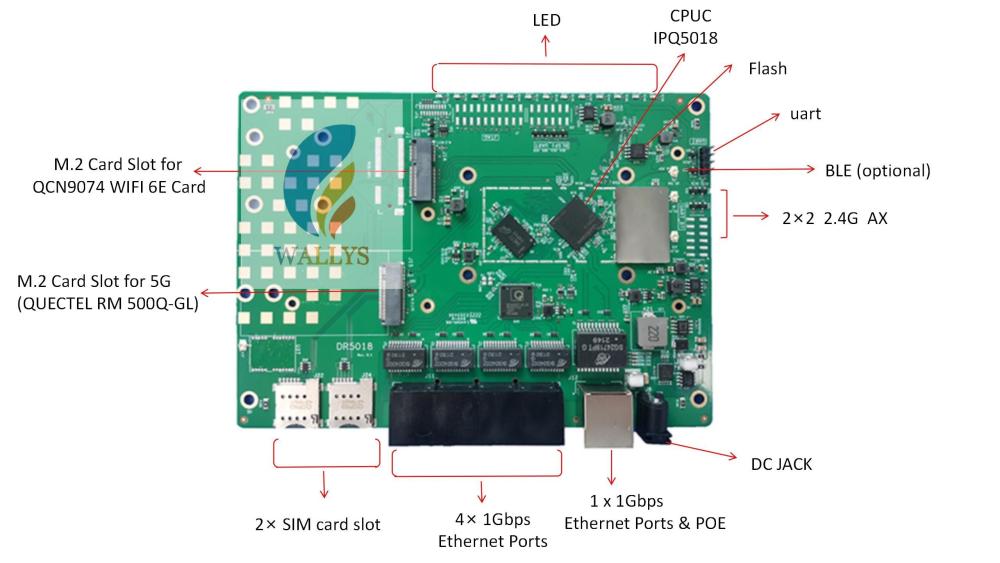Search the Community
Showing results for tags 'ipq5018'.
-
IPQ5018,802.11ax,wifi 6e,QCN9074,2X2 2.4G support 2x WiFi 6E Card support BT5.1/ Dual-core ARM 64bit [email protected] Processor 512MB DDRL3L System Memory 4MB NOR Flash, 128MB NAND Flash 2x2 On-board 2.4GHz radio,up to 573Mbps physical Data Rate Support BT5.1 M.2 Card Slot for 5G (QUECTEL RM 500Q-GL) ; M.2 Card Slot for QCN9074 WIFI 6E Card DR5018 IPQ5018: It's a system-on-chip (SoC) designed by Qualcomm that integrates a quad-core ARM processor, network interfaces, and other hardware components for building networking devices such as routers, gateways, and access points. 802.11ax: Also known as WiFi 6, it's the latest wireless standard that promises faster data transfer rates, better network capacity, and improved performance in crowded environments. It operates in both the 2.4GHz and 5GHz frequency bands. WiFi 6E: It's a new extension of the WiFi 6 standard that adds support for the 6GHz frequency band, which offers more available channels and less interference compared to the 2.4GHz and 5GHz bands. QCN9074: It's a wireless chip designed by Qualcomm that supports the WiFi 6E standard and can deliver up to 2.4Gbps of data transfer rate. 2x2: It refers to the number of antennas used for transmitting and receiving wireless signals. In this case, the device has two antennas for each of the 2.4GHz and 5GHz bands. BT5.1: It's the latest version of Bluetooth, which offers faster data transfer rates, longer range, and improved power efficiency compared to previous versions. Dual-core ARM 64bit [email protected] Processor: It's the CPU (central processing unit) used in the device, which is based on the ARM architecture and has two processing cores running at a clock speed of 1.0GHz. 512MB DDRL3L System Memory: It's the amount of RAM (random access memory) available for the device to run its operating system and applications. 4MB NOR Flash, 128MB NAND Flash: These are the types of non-volatile memory used in the device for storing the firmware and configuration data. M.2 Card Slot for 5G (QUECTEL RM 500Q-GL): It's a slot for inserting an M.2 module that supports 5G cellular connectivity. M.2 Card Slot for QCN9074 WIFI 6E Card: It's a slot for inserting an M.2 module that supports the WiFi 6E standard using the QCN9074 chip. Industry cognitive Stable networks guarantee for the ongoing continuity of your video surveillance. Our boards could establish a stable connected wireless environment which is critical for a security surveillance system. Wallys has been specializing in product design & manufacturing and delivering superior OEM/ODM services in wireless communications. Dedicated to innovative designs for wireless modules. Customization is also supported, We have 90% of the world market, We’re a supplier to Facebook. We’ll start with a quick review of how Wi-Fi has changed over the years. In fact, the earliest generation of 802.11 standard can be traced back to 1997, when the wireless speed is very low, only 2Mbps, it is an original standard of the first generation . With the introduction of 802.11b in 1999, the physical layer speed was increased to 11Mbps and there were very few commercial applications. At that time, Wi-Fi was still far away from people’s lives In 2003, the third generation of the standard, 802.11a/ g. Laptop began to configure wireless network card and home wireless router appeared in large quantity . Wi-fi comes into ordinary family.


